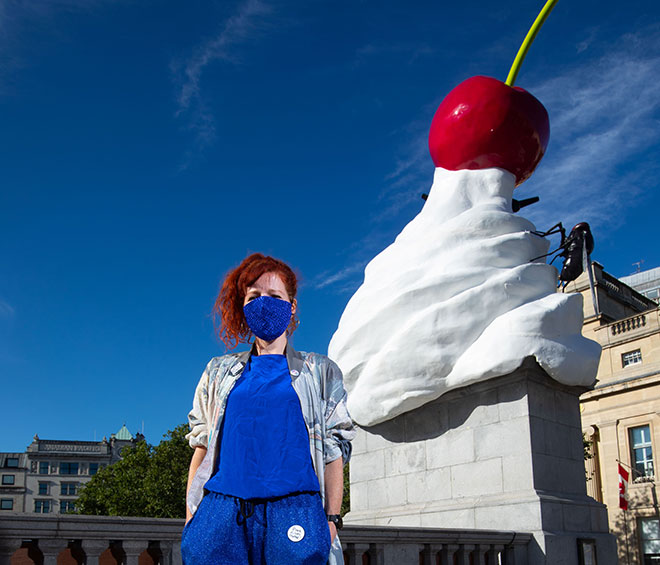
Heather Phillipson with THE END, Fourth Plinth, Trafalgar Square, London, 2020. Photo: David Parry PA.
by JULIET RIX
A towering mass of whipped cream rises over London’s Trafalgar Square, topped by a gaudy red cherry, a repulsive black fly and a whirring, all-seeing drone, streaming live footage to a dedicated website. The tallest plinth sculpture to date, at 9.4 metres (31ft), Heather Phillipson’s superficially humorous work THE END mocks Nelson’s column as it surveys, and is surveyed by, the handful of people left in this iconic, once-crowded, London square.
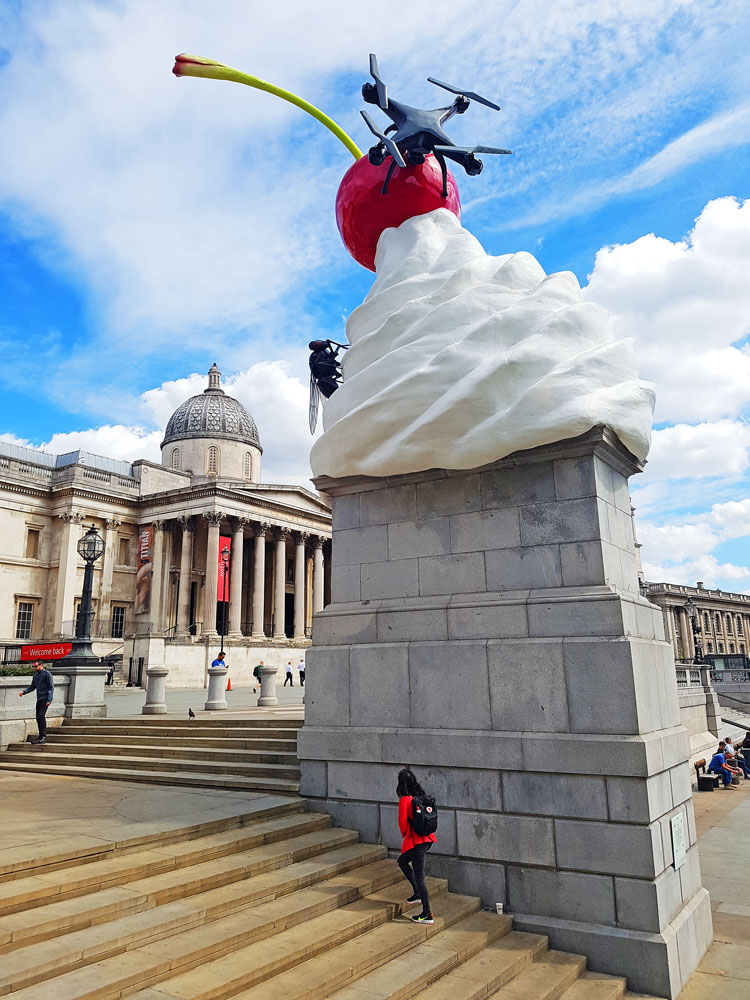
Heather Phillipson, THE END, Fourth Plinth, Trafalgar Square, London, 2020. Photo: Juliet Rix.
It is a site well-known to Phillipson. Born in north London in 1978, she grew up in the south-east of the capital before moving as a teenager to west Wales with her older brother and sister and parents – her mother, a social worker, and her father, a teacher, musician, artist and writer. She now lives and works in east London.
After studying art and design at a local further education college in Pembrokeshire, Phillipson started a fashion course at Central St Martins College of Art and Design in 1997. Disillusioned by her glimpse into that industry, she transferred to a degree in art and philosophy at the University of Wales Institute Cardiff. Postgraduate study brought a return to Central St Martins for a diploma in drawing, followed by a PhD in fine art practice at Middlesex University, completed in 2007.
.jpg)
Heather Phillipson, THE END, Fourth Plinth, Trafalgar Square, London, 2020. Photo: David Parry PA.
Phillipson’s art spans all media – from sculpture and drawing to video, digital and audio. She composes her own music, too, and her musical background ranges from classical and jazz to jungle, house and drum’n’bass, which she DJd in the late 90s at raves and free parties. She is also an award-winning poet with five volumes to her name, and her solo art exhibitions and individual installations have shown at major galleries and events from New York to Istanbul, Frankfurt to Sharjah, as well as in the UK in Gateshead, Dundee and London. Her work is held in the Tate and Arts Council collections, among others.
In 2018-19, Phillipson fulfilled a commission from Art on the Underground by transforming an 80-metre long, disused platform at Gloucester Road tube station into my name is lettie eggsyrub, a vast digital and sculptural installation, in which the vegan artist led the viewer through multiple computer game-like scenes of eggs in various states of torture.
Heather Phillipson, my name is lettie eggsyrub, 2018
Her fourth plinth installation was chosen from a shortlist by public vote at the National Gallery in 2017 and was due to be installed in March 2020. As we speak, via Zoom, she is in her studio working on a new project for the 2021 Tate Britain Duveen Galleries Commission, while THE END, finally installed, is creamily “melting” over Trafalgar Square.
Juliet Rix: How was it having the installation of your fourth plinth work delayed by Covid-19?
Heather Phillipson: Like almost everything else in the world, it had to stop. And that felt right. At the beginning of the pandemic, even if it could have gone ahead, which it couldn’t under increasing lockdown restrictions, it didn’t feel appropriate. It was important for all non-essential activity to pause so we could focus instead on just taking care of each other.
Then it didn’t feel like it was ever going to be the “right” time for it – a moment when things resumed in any way that felt at all normal. So, when some things started opening back up, that seemed like as good a time as any …
JR: I read about it being delayed in March and, given its title, I remember thinking maybe it was a good thing it had been, since it all felt a bit apocalyptic at the time, but you actually made the piece long before the pandemic, didn’t you?
HP: I came up with the idea and title four years ago. You never know what the political, cultural, or sociological context will be by the time a longer-term work like this is manifest. It’s always going to take on different resonances at that future moment – and, of course, it has.
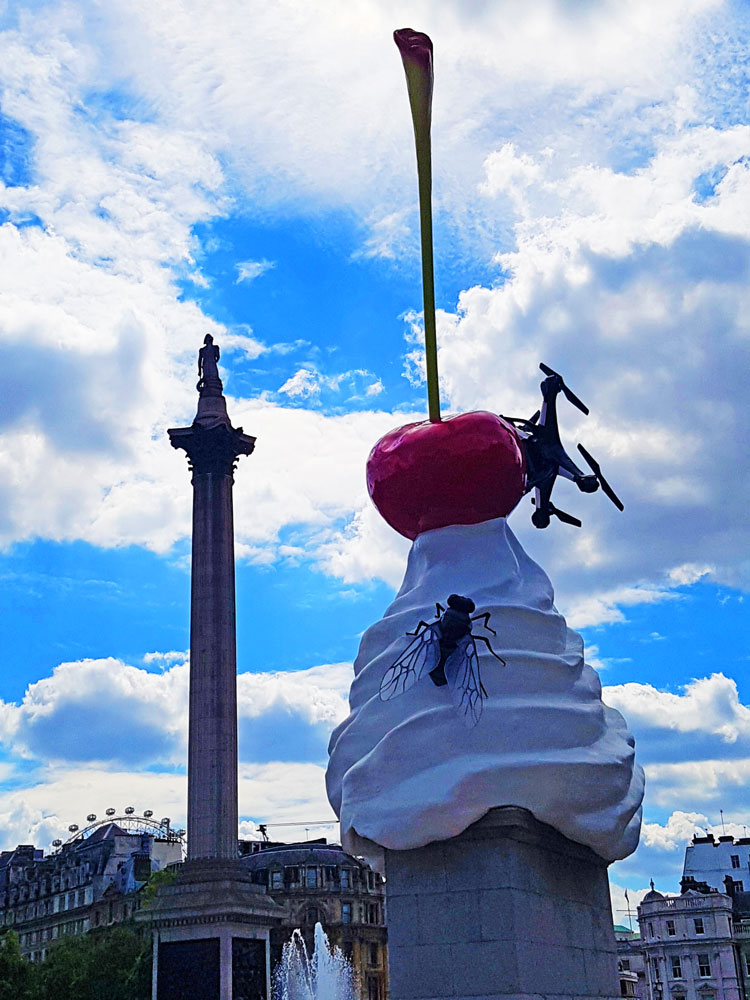
Heather Phillipson, THE END, Fourth Plinth, Trafalgar Square, London, 2020. Photo: Juliet Rix.
JR: It does seem terribly relevant now. If anything, the times seems to have caught up with you. I am not sure if that brings you satisfaction or not?
HP: I have always, on some level, thought of my works as harbingers – one way or another – of good or bad. They’re always embedded in the present, but that includes what the present is anticipating. At any given moment, there are always multiple issues, not necessarily fully visible, but no less urgent, that are underway, and that is true now as well.
Just before the launch of THE END (post-lockdown), I made a new online audio work, VOLTA, to accompany it. I wanted to shift THE END from being something presumed terminal to being also, perhaps, a chance to crack open the potential for change. The audio suggests radical challenges also bring radical possibilities. That an end can also be a beginning.
JR: VOLTA describes an apocalyptic systemic reboot. Is that what you are hoping Covid-19 might be?
HP: I wouldn’t say I’m hoping for anything that specific, although I guess, on some level, I’m always hopeful for a sociological reboot! At the start of lockdown, when everything suddenly halted, it felt like there was a very real chance for radical change, but what seems to be happening now is that things are resuming very much like the old world order, but worse. That’s not to say there’s not hope. There’s always hope. Look at the Black Lives Matter protests a few weeks ago.
At the height of the protests, it felt like a moment of intense energy and possibility, with people risking their lives to gather at demonstrations, and statues representing the UK’s shameful history getting toppled and sunk. But radical shifts don’t happen without a lot of courage, conviction and labour. We have a lot of work to do, together, to make any kind of change.
Lockdown has provided the gift of self-reflection, sociologically, economically, environmentally, in all kinds of ways and any critical reflection has a kernel of hope in it. But there has to be follow-through. Hope is carried on the currents of action.
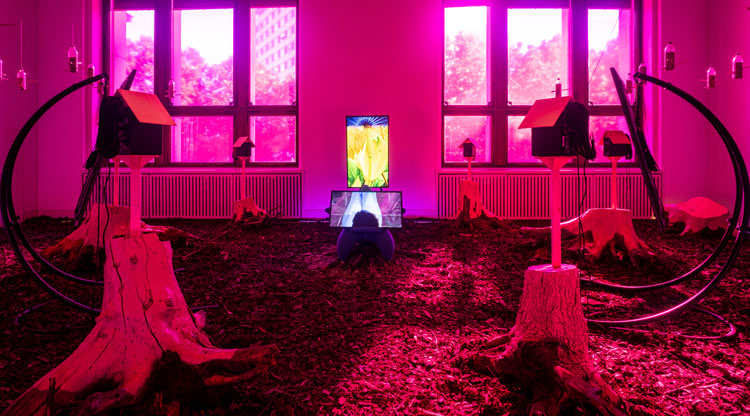
Heather Phillipson, Mesocosmic Indoor Overture, installation view at Martin Gropius Bau, Berlin, 2019. Image courtesy Matthias Voelzke and the artist.
JR: How political is your work? A lot of it has an underlying sense of threat. How directly political do you intend it to be?
HP: It is political, but perhaps with a lowercase p. It’s not necessarily addressing an overt political position, single argument or party line. I don’t really believe in staying faithful to any one discourse, more to the forces and dynamic systems of the work itself. I’m primarily engaged in relationships between things and people, and that’s always political – how we relate to other beings, how we eat together or eat each other [across species], how we speak and listen together, frame thoughts and positions and flex them. Those things are often quite overt in the work, but the work can be read in multiple ways and that’s deliberate. Making a single point is closer to a slogan or advertising and that doesn’t interest me. I’ve always thought my work exists inside the forward slash: it’s this, or this, and this, and also this. But within all that multiplicity, there’s a driving force that’s always political.
JR: When you first created THE END four years ago, did you have a particular “end” in mind, or was it the end of civilisation in general?
HP: It’s about multiple ideas of ending and the possibility inherent within that. It was first developed in 2016, when we had just had the Brexit vote, and it seemed pretty clear that Donald Trump’s election was imminent. As has happened with the pandemic, it felt that those events exposed something already latent, or ignored and now made overt. It felt to me like being alive in a state of emergency. As it does now.

Heather Phillipson, more flinching, installation view at Whitechapel Gallery, London, 2016. Photograph by Tim Bowditch. Image courtesy the artist.
JR: You have long had an interest in environmental issues. Is environmental danger and climate change the next “ending”’ you might be warning against in your work?
HP: The pandemic is not unrelated to the environment and to industrial agriculture, global food production, how we consume and how that’s controlled and distributed. This pandemic appears to have happened very suddenly but, of course, it hasn’t. It’s come about through all these systems becoming more and more extreme. It’s on a different timescale from climate change, but while we’re living through this, we’re also living through climate change: it might be happening slightly slower, but it’s also accelerating. It’s completely interrelated.
JR: THE END is universal and also quite site specific. How much was it inspired by its location?
HP: Completely. I was thinking very specifically about Trafalgar Square and my experience of it primarily as a place of protest. That is how I have mostly experienced it, though also sometimes as a place for festivals/celebrations and, of course, traversing it just getting from here to there. I wanted to respond to the very loaded political position of the site with its military statuary and its proximity to Westminster and the National Gallery and its relationship to empire and history and globalism and capitalism and surveillance and … well, everything that goes on around there.
I didn’t want to just make a scaled-up version of something that could have existed anywhere. The work includes the plinth – the dollop of cream is frothing over its edges. In one way, that’s an overt tactic to undermine and subvert the “status” of sculptures on plinths, as if the sculpture itself has a self-critical awareness of its position. The height of the cherry stalk deliberately relates to the height of the statues around it – to the status that’s conferred through their size. The way things tower over us as citizens, the energies in the air, I was really trying to have a conversation with all those things at once.
JR: When I first looked at it, I saw it not as whipped cream but as Mr Whippy ice-cream, referencing the tourists down below as well as the other things you mention.
HP: To me, it’s cream, but that apparent distinction isn’t really important. Either way, it’s the image of a dairy product on the verge of collapse. It’s a hyper-real form, buoyed up by air, that can only retain its shape for a limited period. Exposed to touch or heat, it collapses.
JR: Although it means fewer people will see the work on site, because there are far fewer people in Trafalgar Square, do you think that absence has made your piece all the more poignant?
HP: I think anything you put on the fourth plinth right now would somehow be read in relation to what’s happening. And, of course, what’s happening changes the resonances and, in some cases, heightens them, especially perhaps the references to surveillance and other life-forms. Importantly, the fact that Trafalgar Square has become a relatively evacuated space now becomes a part of what the drone camera monitors and feeds back, so it also becomes a kind of commentary on public spaces more broadly. As it’s being broadcast online, that live stream also offers the sculpture’s-eye perspective on Trafalgar Square to anyone globally who chooses to tune in. So, its relationship to online “content”, virtual trips and physical absence – what’s accessible to whom, and when – is amplified.
JR: Was streaming live images from the camera in the drone always an integral part of your idea for the plinth?
HP: Yes. It goes back to my experience of being in the square primarily for protests. I wanted the viewer to be able to be in the square and to have an aerial perspective on it at the same time. When you’re protesting, you’re often deep inside it, in a crowd, and you can’t see the scale or the edges. I wanted to offer back a bit of agency – to be able to view as well as be viewed.
JR: I’ve found the drone feed quite compelling. I watched a group of teenagers performing for their mobile phone on a selfie stick and I wondered if they were looking at themselves on the drone stream or performing for their own video unaware that they were also being streamed live across the globe? How many layers of performance and observation were they aware of?
HP: I haven’t watched the drone feed much – maybe I should, but I’ve enjoyed watching people when I’ve been in the square, especially when they access the drone feed and start performing, gesturing or moving to compose themselves for a screenshot. I imagine it’s easy to forget that the broadcast is picked up not only by you, but by others around the plinth and online, so it can also be viewed by a global audience. It’s a much more direct interaction with the work than, say, just standing back to look at it – in a way, you actually are it.
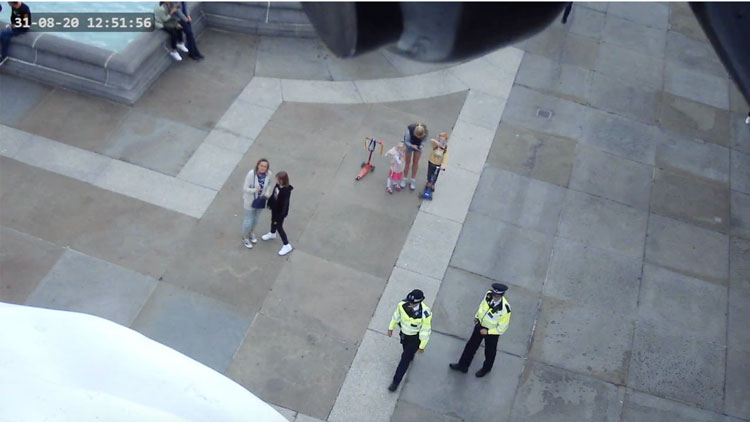
Screenshot from the drone's live feed, 31/08/2020.
With General Data Protection Regulation (GDPR) coming in shortly after I was selected, it required a lot of research and discussion around what was still possible with the live feed. Crucially, it only covers a particular area around the sculpture, and isn’t recorded. I was never interested in keeping people’s images, it was always about transmission and reception, the present moment and the feedback loop. Surveillance happens in all kinds of contexts, and through various means – not only drones, but also CCTV and other people’s phone cameras. Here, you get to be in the rare position of being both the surveiller and the surveilled, the visible subject and the invisible other that’s watching.
JR: You have referred to your work as “quantum thought experiments”?
HP: I started using that phrase because my works are frequently trying to hold seemingly contradictory ideas in the balance, establishing and retracting multiple different perspectives, pulling in multiple directions. They tend to proceed through associative clusters, and that can be through physical objects or digital chunks, or spatial arrangements or temporal sequences. It’s almost always digressive, and always in motion.
JR: You work in a lot of different media. VOLTA alone is a multilayered audio collage of words, sound effects and music; THE END is sculpture, animated elements, moving pictures and digital interaction. What brought you to work in such a mixture?
HP: I guess the simple answer is that I never wanted to have to choose, and that’s one of the privileges of making art. In most other disciplines, you’re pushed in one direction, usually towards an idea of expertise, and expertise has never seemed the route for me.
In fact, I’m always glad when I can return to being an amateur, making it up as I go along, seeing what I can get away with. I often feel the need to run away from whatever I’ve just been doing. After working on the plinth – at such a vast scale, involving large numbers of people – it was a real necessity, and delight, to beat a retreat and make some audio, alone in my studio.
JR: How do you choose which medium to use for a given idea? Does the medium come to you with the idea, or do you match them in some other way?
HP: Things don’t arrive fully formed, and often I work associatively, so things kind of accrue over a period. It’s more to do with what I feel like doing at a given moment. Plus, each medium seems to come with its own way of thinking and creating. Writing, video and audio are all solitary activities for me, and so generate a particular kind of intimacy with the medium. It’s a very different relationship to installing large-scale shows, involving conversations with many people, and often with a particular space, and even with entirely different countries and cultures.
JR: Do you like working in a site-specific way?
HP: I think the only truly site-specific works I’ve made have been Gloucester Road tube station and the fourth plinth – and, even then, maybe they’re more site-responsive. Generally, I would say it’s more that I take the architecture into account so that, as with the fourth plinth, certain elements of the space or site inform the tone or structure of the work – the way the light hits, the height of the ceilings, how you pass through and around it. My large-scale installations are often hermetic environments, taking over entire rooms, exploding from their edges, so it’s important to feel where the pressure is in that room and to work into it.
JR: You’ve been commissioned to do the next Tate Britain commission for the Duveen Galleries. That will presumably be another work taking over and responding to a particular space?
HP: Yes, and the Duveen Galleries have a neoclassical, very “European”, reverential kind of architecture, with those arches and columns, and vast space and light overhead. All that, for me, is there to be utilised and, maybe, upturned.
JR: What plans do you have for the Tate commission?
HP: It’s all a bit tentative at the moment! My previous plans are, like everything else, under review. The pandemic has brought in all kinds of new regulations around social distancing and flow through the galleries that impact what’s possible inside the space. Often, in my more room-filling works, how you move across the space, how one thing precedes and succeeds another, what’s visible when, how you enter and exit, is key to the work. The way you move through Tate Britain has changed, so now the work has to change, too. But my fundamental concerns remain the same. It will still have an environmental theme and involve deranged landscapes, hot spots, mutant creatures and plenty of audio visual.
JR: It sounds as though you have been quite busy in lockdown?
HP: Actually, I just stopped. I could really exist only in the present tense, and it felt inappropriate to keep on with all the old stuff as if the world wasn’t imploding around me. It felt like the future tense had ceased to exist.
I was lucky that I was able to stop. I didn’t go to my studio, but instead began reading all those books that had been accumulating around me. I meditated and walked the dog and rethought everything. I resumed a daily practice of drawing, with fat marker pens on cardboard – digging around in the estate recycling bins, which were overflowing with packaging from home deliveries. I was really capable only of brief bursts.
And then things started to resume and I felt ready to do the same.
JR: Do you think this period will change your work, or were your themes – as we have seen with the plinth – already so in tune with the times that not much will change?
HP: The concerns, themes, were already there, but the drawing is definitely a practice I’d like to maintain. Usually, if I’m working towards a big show, it’s head-down, no time for cardboard and marker pens. But just being solo and manual and walking around – that’s something I want to cultivate.
JR: You also have a strong interest in music. Have you been working much with that?
HP: I’d say that music is the starting point of almost everything for me. I approach my work, across all media, primarily in musical terms – rhythm, cadence, tonality, counterpoint, harmony and dissonance. And it’s unusual for my work not to use sound. Even when there’s no actual audio, as with the fourth plinth and Gloucester Road underground station, the form of the work is still informed by noise and the surrounding ambience.
JR: You have said that your parents encouraged your interest in becoming an artist. Many youngsters don’t have that support. I know you are involved with mentoring for Arts Emergency, supporting teenagers from disadvantaged backgrounds who are interested in becoming artists. How important is that work to you?
HP: It’s essential. I was very lucky to have that encouragement because it’s quite hard to find the motivation to keep going at a certain point in your life when you realise how financially unviable it is. And it seems, more and more, that art is a really hard area to get started in unless you’re from a wealthy background. Much more so now than when I was starting out. Almost my entire education was free. There were no tuition fees then, I had a maintenance grant throughout my undergraduate course, did my postgraduate course for free because I was signing on at the time. I got a studentship for my PhD and I’ve signed on several times over the years. Via Arts Emergency, I get to give something back. I’m paired each year with a young person, usually around aged 16, who is interested in pursuing art. We have conversations about university choices and applications, the work itself, life as an artist, sustaining a practice while trying to earn a living and all those conflicting demands. Arts Emergency is just a brilliant, vital programme.
JR: The pandemic period has seen the publication of the first full monograph of your work. How has that been?
HP: Amazing and, like all the other stuff, also delayed! Which was fine. I worked with a wonderful editor and graphic designer, both of whom really got it, and it was very much a team effort, meaning that it feels like it really reflects my practice. It’s very informative even for me to see all this stuff side by side, because that’s how it is my head – each thing is always a means of getting to the next thing.
JR: Apart from the Tate commission, what is next?
HP: I’m about to record a Private Passions for BBC Radio 3, where you’re invited to select your most cherished or important pieces of classical music – exciting because it’s basically an excuse to do a lot of listening, with real attention. My list is currently almost infinite, and refining it will be the hard part – and the fun part. Being required to reflect is a luxury. You get to find out what you really think and dig down. Who knows what may come out of that process.
• Heather Phillipson’s fourth plinth, THE END, will be in Trafalgar Square until spring 2022. The live feed can be found here, theend.today, along with the audio work VOLTA. There is an audio description of the sculpture on the fourth plinth website, https://tinyurl.com/y6lv35mp, and a braille description and image at the site.
Heather Phillipson, edited by Leila Hasham, is published by Prestel, London, 2020.